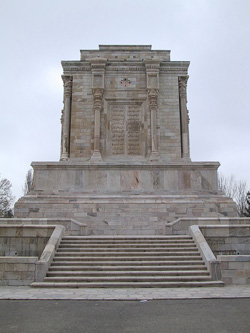Ferdowsi is widely regarded as the preserver of the Persian language and of pre-Islamic Iranian cultural identity. Of all the peoples conquered by the Arabs in the seventh century, the Persians are the only ones who can boast a major literature in the indigenous language that they were using before the conquest. When asked recently why the vast majority of Egyptians, the heirs to a great pre-Islamic civilization, speak Arabic rather than Coptic, a leading Egyptian historian replied: ‘Because we had no Ferdowsi.’

Hakim Abu’l-Qasem Ferdowsi (940–1025) was born in the family of wealthy land owners (the class known as dehqan) in Tus, in northeast Iran’s province of Khorasan (today’s Razavi Khorasan state). His life coincided with a period of intense interest in Persian traditions. After the collapse of the Sasanian Empire, Iran offered the Arab conquerors ancient models of kingship that they could adopt in order to legitimize and solidify their dominance over peoples of diverse cultural and religious backgrounds. Iran also provided the Caliphate of the ‘Abbasid dynasty (750–1258), centred in its new metropolis, Baghdad, close to the former Persian capital at Ctesiphon, with an army of experienced administrative and military governors who managed its expanding territories and gradually established their regional autonomy. Throughout the ninth and tenth centuries much of Iran was controlled by local dynasties that claimed their right to rule by virtue of their Persian descent and eroded the authority of the ‘Abbasids. The Saffarids (861–1003) ruled over Sistan, the homeland of the great Persian hero Rostam in southeastern Iran (at that period including much of Helmand Province in southwest Afghanistan today). The Samanids (819–999), who controlled Khorasan and Transoxiana in northeast Iran, with their capital in Bokhara, revived the official use of the Persian language and sponsored some of the earliest literary works to be written in New Persian. They came from the same landowning class as Ferdowsi and claimed descent from Bahram Chubineh, the famous general in the Shahnameh who belonged to the noble Parthian family of the Mehrans [No. 79]. Their rivals in western Iran, the Buyids (945–1055), although of Arab origin, claimed descent from the Sasanian king Bahram V, the Shahnameh’s Bahram Gur [No. 68]. Both the Samanids and the Buyids revived the old Sasanian title of ‘King of Kings’ (Shahanshah).
During the Arab invasion of the seventh century and for some time afterwards, Ferdowsi’s native Tus was ruled by the Kanarang family of noble Parthian stock. A mid-tenth century descendant of this family entrusted scholars steeped in Pahlavi and in the Zoroastrian world-view with the collation of pre-Islamic Persian documents and the Sasanian ‘Book of Kings’ (Khwaday-namag), which resulted in a prototype prose version of the Shahnameh in New Persian completed in 957. The continuing vigour of the prestigious Persian administrative system and government models, the survival of the former Persian gentry, and the independent spirit of minor potentates on the peripheries of the Iranian Plateau, nurtured Persian traditions and consciousness. Known as the ‘Iranian intermezzo’, this period of revival of Persian identity fell between 945, when the Buyids took Baghdad and challenged the power of the ‘Abbasid Caliphs in their own capital, and the arrival from the mid-eleventh century onwards of a succession of Turkic and Inner Asian.

Whatever hopes Ferdowsi may have held of the revival of Persian fortunes under the Samanid family, they were frustrated by the collapse of their rule and the rise of the Ghaznavid dynasty (977–1186), upstarts of Turkic slave origin who had distinguished themselves in the Samanids’ military service in Khorasan. Having worked on the Shahnameh for thirty-five years, Ferdowsi dedicated the final version to Sultan Mahmud of Ghazni (997–1030), hoping to inspire him as a new champion of ancient Persian glory. Known for his patronage of poetry and the arts, Mahmud was the obvious, in fact the only contemporary monarch to whom Ferdowsi could offer his epic. However, the pro-Caliphate sultan, who was a militant Sunni and the grandson of a Turkic slave, could hardly have appreciated a poem marked by anti-Arab, anti-Turk, pro-royalist and pro-Shi‘i sentiments.
The Shahnameh offers evidence for Ferdowsi’s devotion to the Shi‘i branch of Islam, which maintains that Mohammad’s family, his cousin and son-in-law ‘Ali, and the Imams descended from him are the rightful spiritual leaders. A copy of the Shahnameh made in Tabriz in 1536 shows the Prophet Mohammad and ‘Ali in the Ship of Shi‘ism, while references in the text to the Orthodox caliphs, Mohammad’s closest companions and leaders of his tribe, who are accepted by Sunni Muslims as the Prophet’s true successors, have been scratched out [No. 2]. Ferdowsi did not discuss the origins of Islam in the Shahnameh. A mid-twelfth century source claimed that he had been denied burial in the Muslim cemetery for being a ‘heretic’. Indeed, Ferdowsi was buried in his family estate, where his mausoleum, built in 1925, now stands.

Ferdowsi’s mausoleum
On the other hand, the Shahnameh includes a passage on the emergence of Zaratushtra and the adoption of Zoroastrianism by the Iranian king Goshtasp. Curiously, this is the only fragment that Ferdowsi borrowed from the first versified version of the Shahnameh in New Persian, written by Abu Mansur Daqiqi (c.935–c.976). Daqiqi enjoyed a reputation as a bohemian Zoroastrian and Ferdowsi was careful not to associate himself too closely with the account of Zoroastrianism, wherever his own personal sympathies may have lain.
The paradoxical situation of the Shahnameh’s dedication to Sultan Mahmud of Ghazni gave rise to numerous legends. The most popular of them recounts how the old Ferdowsi arrived at the capital and managed to penetrate into the Sultan’s garden, where the three chief court poets were involved in erudite conversation [No. 1 No. 44] . Ferdowsi passed their test and was introduced to Mahmud himself. But the sultan rejected the epic, which, together with the jealousy of the court poets, may explain why the Shahnameh was nearly forgotten for two centuries after Ferdowsi’s death.




